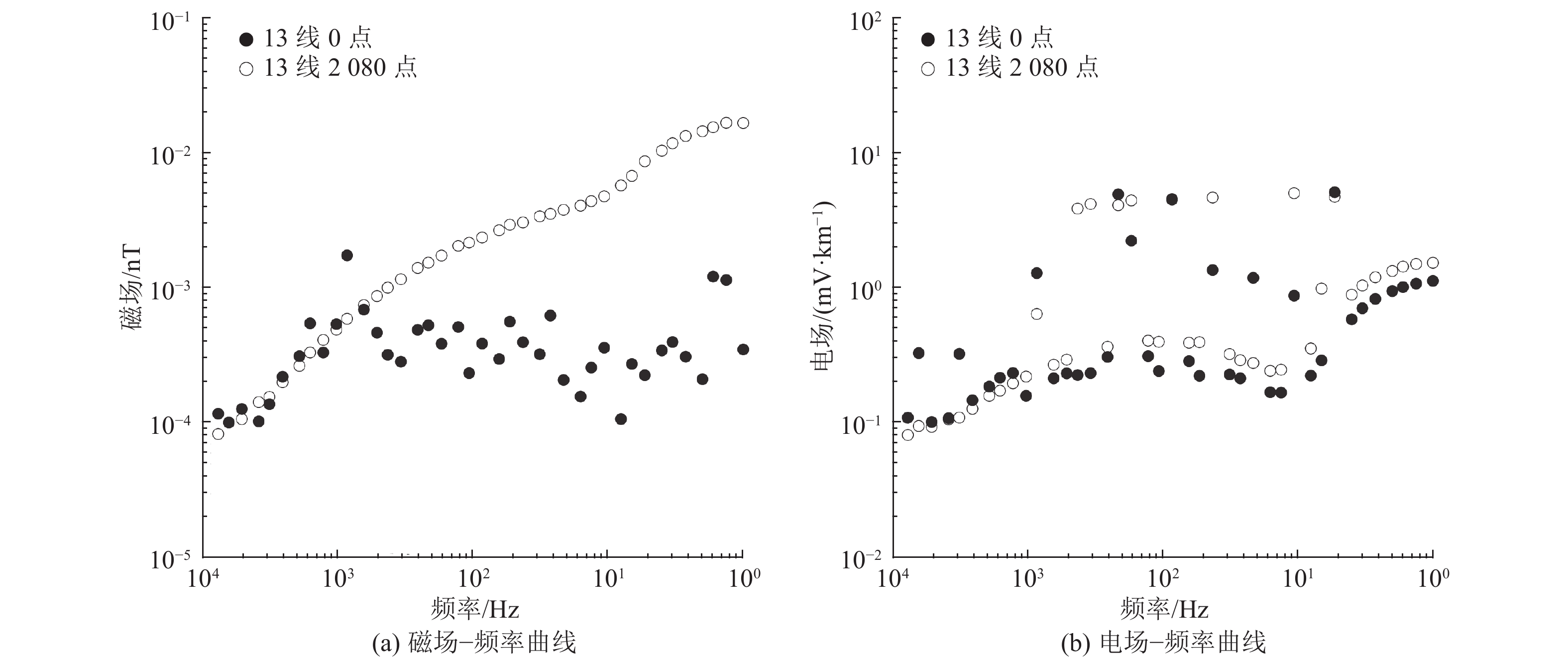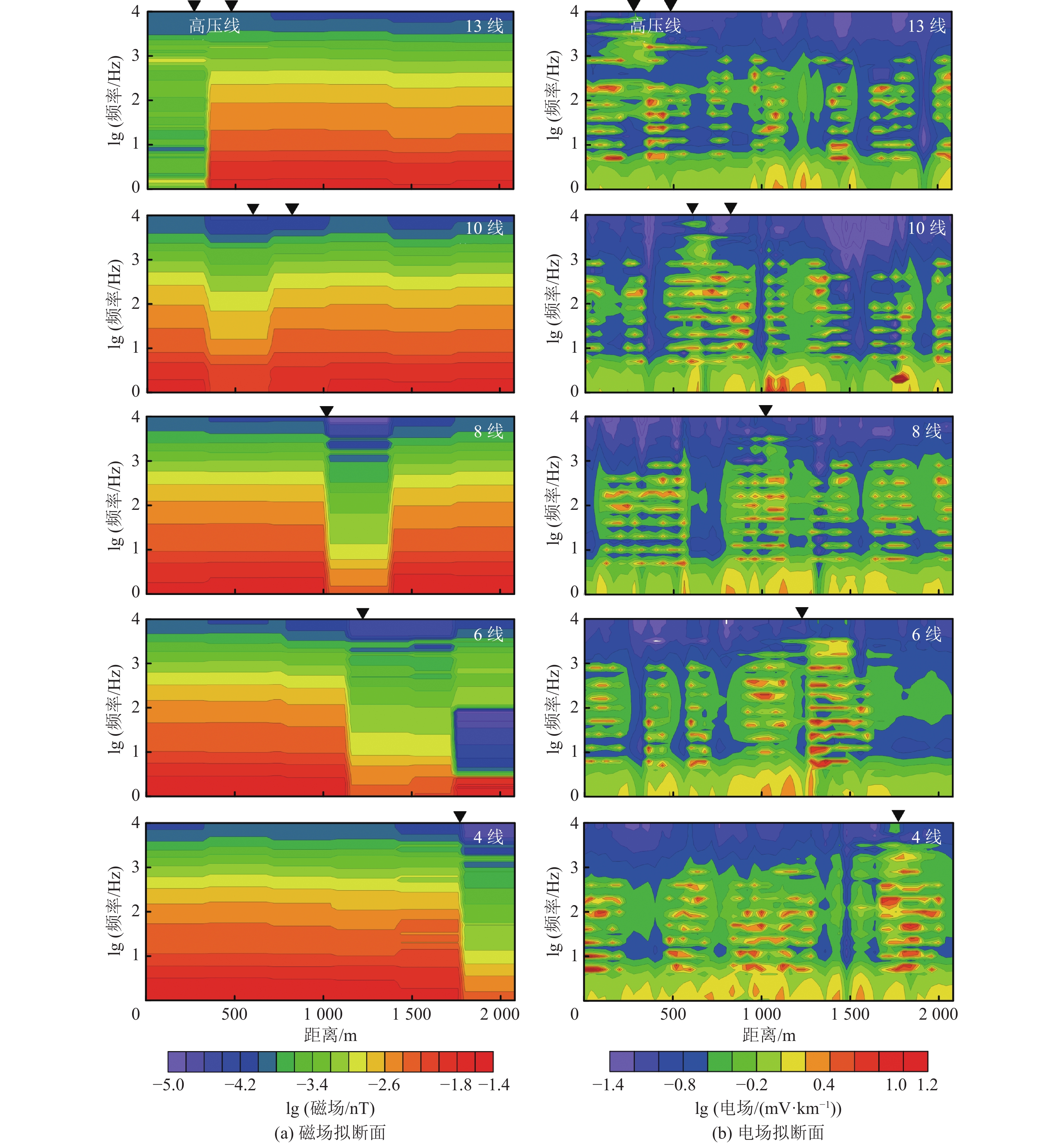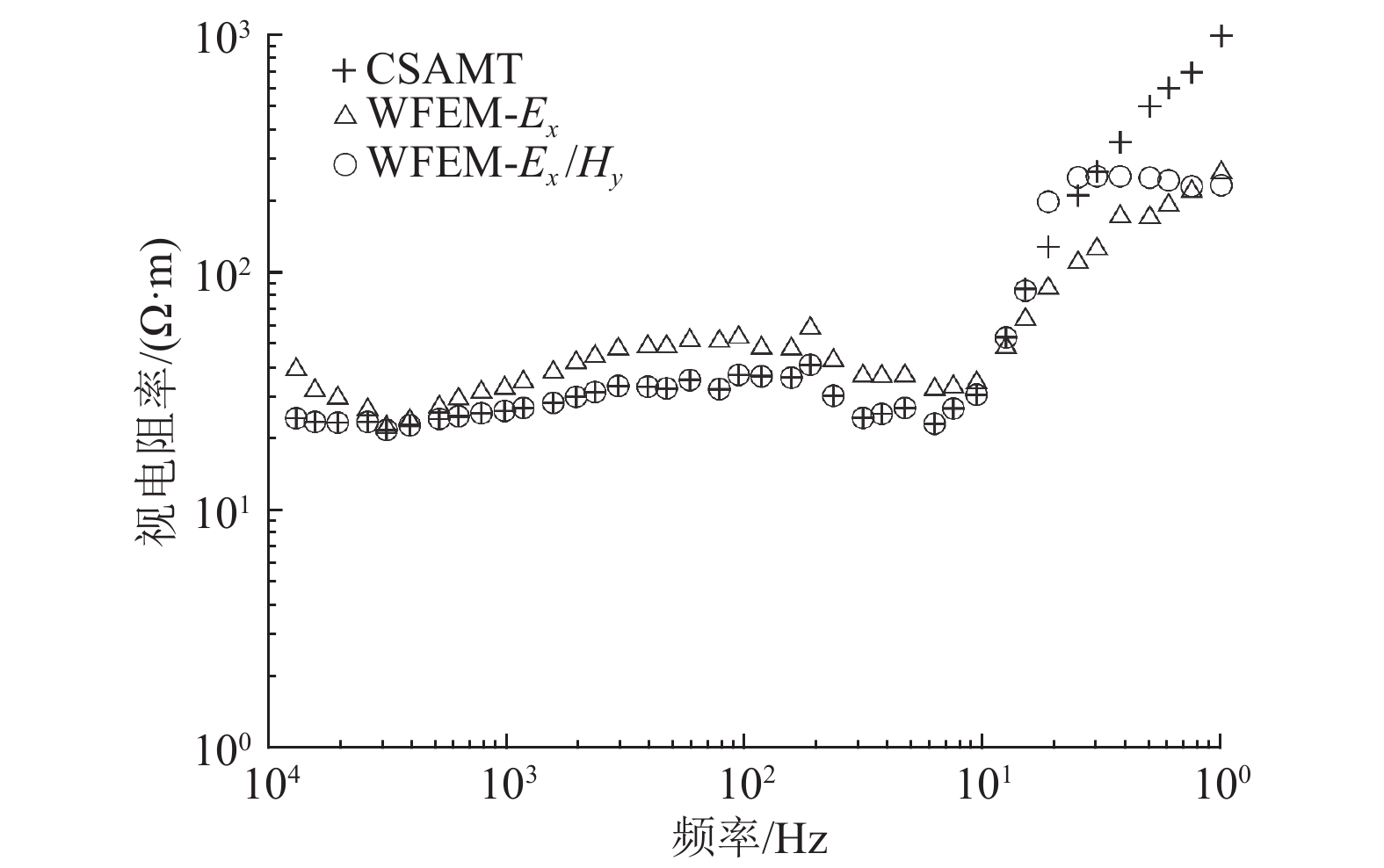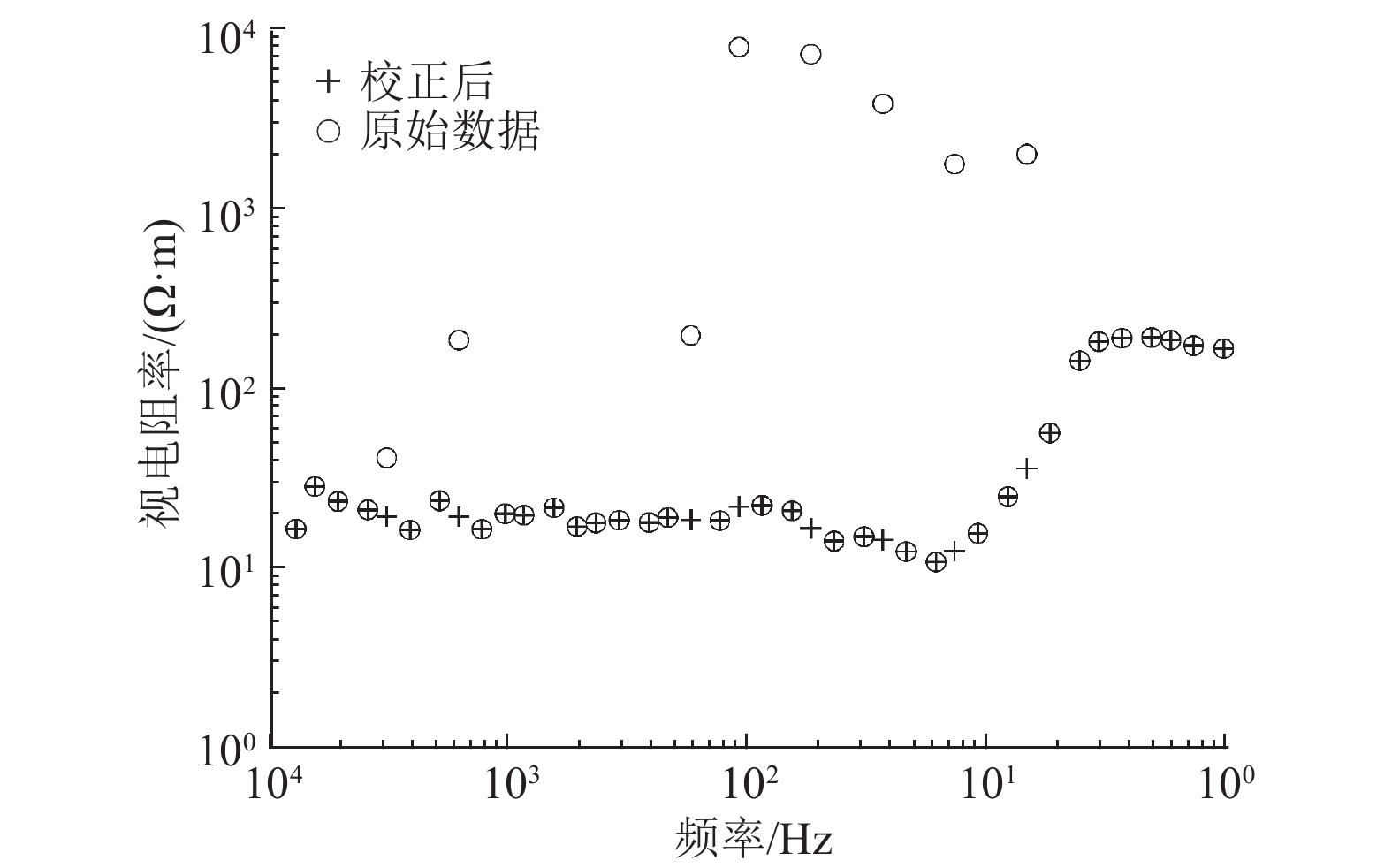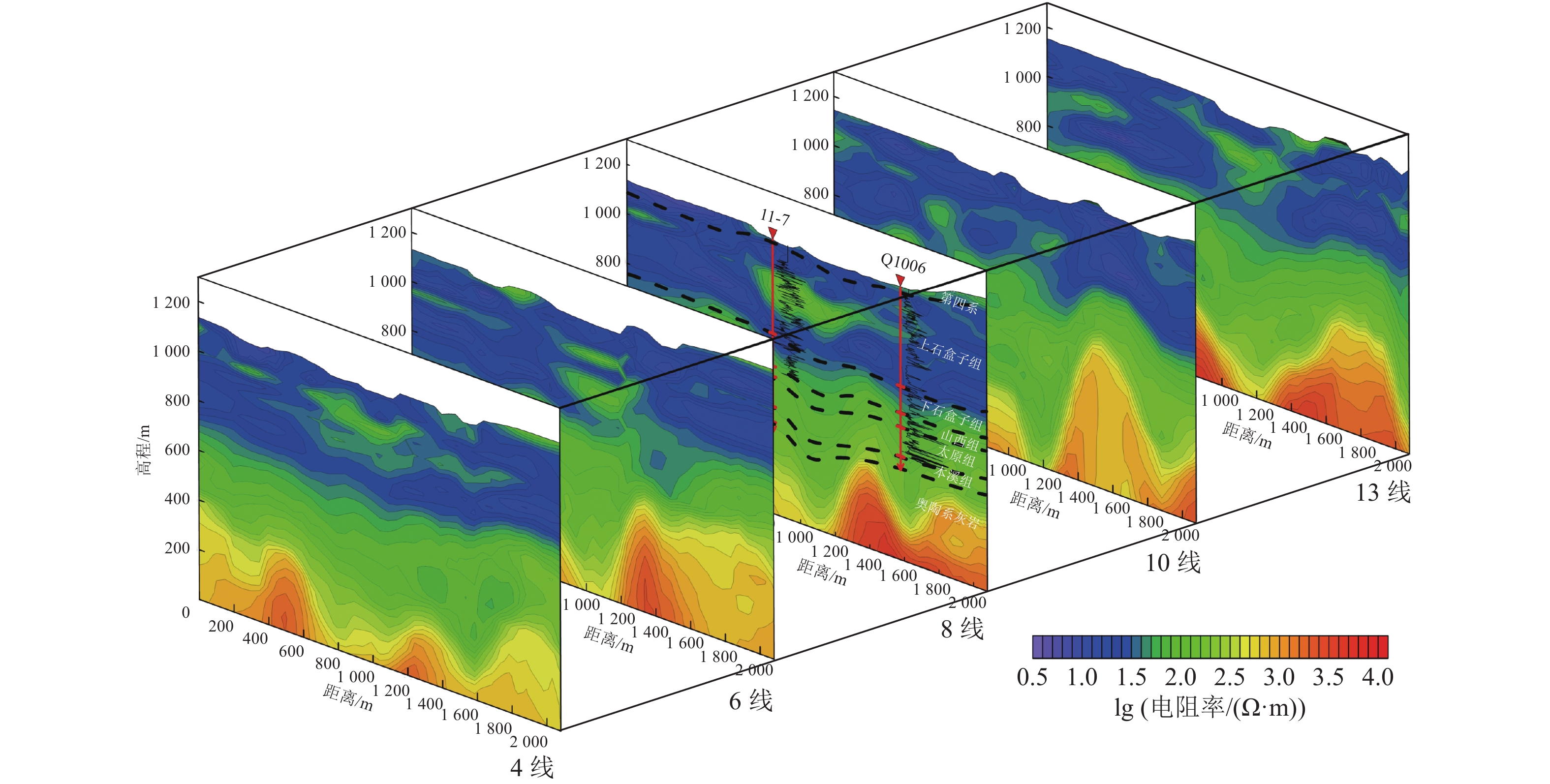-
摘要:
某煤矿采用V8多功能电法仪开展CSAMT探测试验,由于研究区内电磁干扰严重,得出的卡尼亚视电阻率质量较低。为了提高视电阻率数据的质量及其利用率,尝试采用广域电磁法进行CSAMT数据的处理,分别应用单分量电场法、比值法(电场和磁场相比)计算广域视电阻率。结果表明:由于V8施工时不采集场源发射电流,单分量电场法计算结果误差较大;比值法的计算结果在高频段与卡尼亚视电阻率一致,但在低频段优于卡尼亚视电阻率,与实际地电情况更吻合;比值法广域视电阻率的反演结果准确地揭示了矿区含煤地层和奥陶系灰岩的界面,地层解释结果与钻探结果一致,验证了广域电磁法在煤矿CSAMT数据处理中的可行性和有效性。研究成果为其他矿产资源的CSAMT数据处理提供参考。
Abstract:A CSAMT detection test was carried out for a coal mine with V8 multi-functional electrical instrument. Due to the serious electromagnetic interference within the area, the Cagniard apparent resistivity was low in quality. In order to improve the quality and utilization rate of data, authors attempted to process the CSAMT data collected by V8 with the wide field electromagnetic method, which used single-component method and ratio method (Electric field divided by magnetic field) to calculate apparent resistivity. The results showed that there was some deviation between the single-component wide field apparent resistivity and the actual terrestrial electricity because the emission current was not measured during the construction of V8. The wide field apparent resistivity of ratio method was agree with the Cagniard apparent resistivity in the high frequencies but significantly better in the low frequencies, and consistent with the actual terrestrial electricity. In addition, the inversion results of the ratio method wide field apparent resistivity accurately reflected the interface between the coal measure strata and the Ordovician limestone. The geological interpretation corresponded well with the drilling results, which verified the feasibility and effectiveness of wide field electromagnetic method in CSAMT data processing for coal mines.The research results also provide references for CSAMT data processing of other mineral resources.
-
-
表 1 发送频率和理论电流
Table 1 Frequencies and currents of emission
频率/Hz 电流/A 频率/Hz 电流/A 7680 4.97 85.33333325 14.99 6400 5.83 64 15.00 5120 7.00 53.33333334 15.00 3840 8.63 42.66666662 15.00 3200 9.67 32 15.00 2560 10.89 26.66666667 15.00 1920 12.22 21.33333331 15.00 1600 12.90 16 15.00 1280 13.55 13.33333333 15.00 1024 14.03 10.66666666 15.00 853.3333 14.30 8 15.00 640 14.60 6.666666667 15.00 512 14.74 5.333333328 15.00 426.6666667 14.82 4 15.00 341.333333 14.88 3.333333334 15.00 256 14.93 2.666666664 15.00 213.3333334 14.95 2 15.00 170.6666665 14.97 1.666666667 15.00 128 14.98 1.333333332 15.00 106.6666667 14.99 1 15.00 -
[1] 申宝宏, 雷毅, 刘见中. 中国煤矿灾害防治战略研究[M]. 徐州: 中国矿业大学出版社, 2011. [2] 程建远,石显新. 中国煤炭物探技术的现状与发展[J]. 地球物理学进展,2013,28(4):2024−2032. DOI: 10.6038/pg20130446 CHENG Jianyuan,SHI Xianxin. Current status and development of coal geophysical technology in China[J]. Progress in Geophysics,2013,28(4):2024−2032. DOI: 10.6038/pg20130446
[3] 李文. 煤矿采空区地面综合物探方法优化研究[J]. 煤炭科学技术,2017,45(1):194−199. LI Wen. Optimization study of surface comprehensive geophysical detection methods of coal mine goafs[J]. Coal Science and Technology,2017,45(1):194−199.
[4] 武欣,潘冬明,于景邨. 煤矿采空区地球物理探测方法综述[J]. 地球物理学进展,2022,37(3):1197−1206. DOI: 10.6038/pg2022GG0128 WU Xin,PAN Dongming,YU Jingcun. Review in the geophysical methods for coalmine goaf prospecting[J]. Progress in Geophysics (in Chinese),2022,37(3):1197−1206. DOI: 10.6038/pg2022GG0128
[5] 李帝铨,肖教育,张继峰,等. WFEM与CSAMT在新元煤矿富水区探测效果对比[J]. 物探与化探,2021,45(5):1359−1366. LI Diquan,XIAO Jiaoyu,ZHANG Jifeng,et al. Comparison of application effects of WFEM and CSAMT in water–rich area of Xinyuan Coal Mine[J]. Geophysical & Geochemical Exploration,2021,45(5):1359−1366.
[6] 底青云,UNSWORTH M,王妙月. 复杂介质有限元法2.5维可控源音频大地电磁法数值模拟[J]. 地球物理学报,2004,47(4):723−730. DOI: 10.3321/j.issn:0001-5733.2004.04.026 DI Qingyun,UNSWORTH M,WANG Miaoyue. 2.5–D CSAMT modeling with the finite element method over 2–D complex earth media[J]. Chinese Journal of Geophysics,2004,47(4):723−730. DOI: 10.3321/j.issn:0001-5733.2004.04.026
[7] 汤井田, 何继善. 可控源音频大地电磁法及其应用[M]. 长沙: 中南大学出版社, 2005. [8] 袁桂琴,熊盛青,孟庆敏,等. 地球物理勘查技术与应用研究[J]. 地质学报,2011,85(11):1744−1805. YUAN Guiqin,XIONG Shengqing,MENG Qingmin,et al. Application research of geophysical prospecting techniques[J]. Acta Geologica Sinica,2011,85(11):1744−1805.
[9] 刘最亮,张奋轩,张继锋,等. 基于 CSAMT 电场分量的电性标志层深度校正技术及应用[J]. 煤田地质与勘探,2021,49(4):24−32. DOI: 10.3969/j.issn.1001-1986.2021.04.004 LIU Zuiliang,ZHANG Fenxuan,ZHANG Jifeng,et al. Depth correction technique of electrical marker based on electrical field component of CSAMT[J]. Coal Geology & Exploration,2021,49(4):24−32. DOI: 10.3969/j.issn.1001-1986.2021.04.004
[10] 何继善. 广域电磁法和伪随机信号电法[M]. 北京: 高等教育出版社, 2010. [11] 李帝铨,胡艳芳. 强干扰矿区中广域电磁法与CSAMT探测效果对比[J]. 物探与化探,2015,39(5):967−972. LI Diquan,HU Yanfang. A comparison of wide field electromagnetic method with CSAMT method in strong interferential mining area[J]. Geophysical & Geochemical Exploration,2015,39(5):967−972.
[12] 朱威,范翠松,姚大为,等. 矿集区大地电磁噪声场源分析及噪声特点[J]. 物探与化探,2011,35(5):658−662. ZHU Wei,FAN Cuisong,YAO Dawei,et al. Noise source analysis and noise characteristics study of MT in an ore concentration area[J]. Geophysical & Geochemical Exploration,2011,35(5):658−662.
[13] 武军杰,邓晓红,张杰,等. 强干扰区电磁法勘探抗干扰措施及效果分析[J]. 物探化探计算技术,2013,35(1):40−46. DOI: 10.3969/j.issn.1001-1749.2013.01.07 WU Junjie,DENG Xiaohong,ZHANG Jie,et al. The anti–interference measures with electromagnetic method in noisy area strong level and the analysis of effect[J]. Computing Techniques for Geophysical and Geochemical Exploration,2013,35(1):40−46. DOI: 10.3969/j.issn.1001-1749.2013.01.07
[14] 汤井田,任政勇,周聪,等. 浅部频率域电磁勘探方法综述[J]. 地球物理学报,2015,58(8):2681−2705. DOI: 10.6038/cjg20150807 TANG Jingtian,REN Zhengyong,ZHOU Cong,et al. Frequency–domain electromagnetic methods for exploration of the shallow subsurface:A review[J]. Chinese Journal of Geophysics (in Chinese),2015,58(8):2681−2705. DOI: 10.6038/cjg20150807
[15] 杨洋. 基于周期特征提取有效信号的去噪方法研究[D]. 长沙: 中南大学, 2017. YANG Yang. Research on extraction for useful signal and denoising method based on periodic feature[D]. Changsha: Central South University, 2017.
[16] 杨洋,何继善,李帝铨. 在频率域基于小波变换和Hilbert解析包络的CSEM噪声评价[J]. 地球物理学报,2018,61(1):344−357. DOI: 10.6038/cjg2018L0298 YANG Yang,HE Jishan,LI Diquan. A noise evaluation method for CSEM in the frequency domain based on wavelet transform and analytic envelope[J]. Chinese Journal of Geophysics,2018,61(1):344−357. DOI: 10.6038/cjg2018L0298
[17] YANG Yang,LI Diquan,TONG Tiegang,et al. Denoising controlled–source electromagnetic data using least–squares inversion[J]. Geophysics,2018,83(4):1JA−Z18. DOI: 10.1190/geo2018-0625-tiogeo.1
[18] 胡艳芳. 基于聚类方法的CSEM频率域信噪分离研究[D]. 长沙: 中南大学, 2021. HU Yanfang. Noise separation study of CSEM data in frequency domain based on clustering method[D]. Changsha: Central South University, 2021.
[19] 吕庆田,张晓培,汤井田,等. 金属矿地球物理勘探技术与设备:回顾与进展[J]. 地球物理学报,2019,62(10):3629−3664. DOI: 10.6038/cjg2019N0056 LYU Qingtian,ZHANG Xiaopei,TANG Jingtian,et al. Review on advancement in technology and equipment of geophysical exploration for metallic deposits in China[J]. Chinese Journal of Geophysics (in Chinese),2019,62(10):3629−3664. DOI: 10.6038/cjg2019N0056
[20] 李春兰. 七元煤矿矿区水文地质条件[J]. 科技创新导报,2010(10):50. DOI: 10.3969/j.issn.1674-098X.2010.10.036 LI Chunlan. The–hydro–geological conditions of Qiyuan Coal Mining[J]. Science and Technology Innovation Herald,2010(10):50. DOI: 10.3969/j.issn.1674-098X.2010.10.036
[21] 穆金霞. 七元煤矿水文地质条件分析及涌水量估算[J]. 煤炭与化工,2021,44(12):64−68. DOI: 10.19286/j.cnki.cci.2021.12.019 MU Jinxia. Hydrogeological condition analysis and water inflow estimation in Qiyuan Mine[J]. Coal and Chemical Industry,2021,44(12):64−68. DOI: 10.19286/j.cnki.cci.2021.12.019
[22] 张继锋,周光裕,刘最亮,等. E–Ex广域电磁法横向约束反演[J]. 煤炭学报,2022,47(7):2698−2707. ZHANG Jifeng,ZHOU Guangyu,LIU Zuiliang,et al. Lateral constrained inversion of E–Ex wide field data[J]. Journal of China Coal Society,2022,47(7):2698−2707.
[23] 何继善. 广域电磁测深法研究[J]. 中南大学学报(自然科学版),2010,41(3):1065−1072. HE Jishan. Wide field electromagnetic sounding methods[J]. Journal of Central South University (Science and Technology),2010,41(3):1065−1072.
[24] 何继善. 大深度高精度广域电磁勘探理论与技术[J]. 中国有色金属学报,2019,29(9):1809−1816. HE Jishan. Theory and technology of wide field electromagnetic method[J]. The Chinese Journal of Nonferrous Metals,2019,29(9):1809−1816.
[25] 何继善. 广域电磁法理论及应用研究的新进展[J]. 物探与化探,2020,44(5):985−990. HE Jishan. New research progress in theory and application of wide field electromagnetic method[J]. Geophysical & Geochemical Exploration,2020,44(5):985−990.
[26] 王顺国,熊彬. 广域视电阻率的数值计算方法[J]. 物探化探计算技术,2012,34(4):380−383. DOI: 10.3969/j.issn.1001-1749.2012.04.02 WANG Shunguo,XIONG Bin. Numerical calculation methods of wide field apparent resistivity[J]. Computing Techniques for Geophysical and Geochemical Exploration,2012,34(4):380−383. DOI: 10.3969/j.issn.1001-1749.2012.04.02
[27] 索光运,李帝铨,胡艳芳. 基于解析雅克比矩阵的E–Ex广域电磁法一维并行约束反演[J]. 物探化探计算技术,2019,41(1):55−61. DOI: 10.3969/j.issn.1001-1749.2019.01.009 SUO Guangyun,LI Diquan,HU Yanfang. One–dimension parallel constrained inversion of E–Ex wide field electromagnetic method based on analytical Jacobian matrix[J]. Computing Techniques for Geophysical and Geochemical Exploration,2019,41(1):55−61. DOI: 10.3969/j.issn.1001-1749.2019.01.009
[28] 张乔勋,李帝铨,田茂军. 广域电磁法在赣南某盆地油气勘探中的应用[J]. 石油地球物理勘探,2017,52(5):1085−1092. DOI: 10.13810/j.cnki.issn.1000-7210.2017.05.023 ZHANG Qiaoxun,LI Diquan,TIAN Maojun. Application of wide field electromagnetic method to the hydrocarbon exploration in a basin of South Jiangxi[J]. Oil Geophysical Prospecting,2017,52(5):1085−1092. DOI: 10.13810/j.cnki.issn.1000-7210.2017.05.023
[29] 朱云起,李帝铨,王金海. 基于MySQL的广域电磁法数据处理与解释软件[J]. 物探与化探,2021,45(4):1030−1036. ZHU Yunqi,LI Diquan,WANG Jinhai. Wide field electromagnetic data processing and interpretation platform based on MySQL[J]. Geophysical & Geochemical Exploration,2021,45(4):1030−1036.








 下载:
下载:


